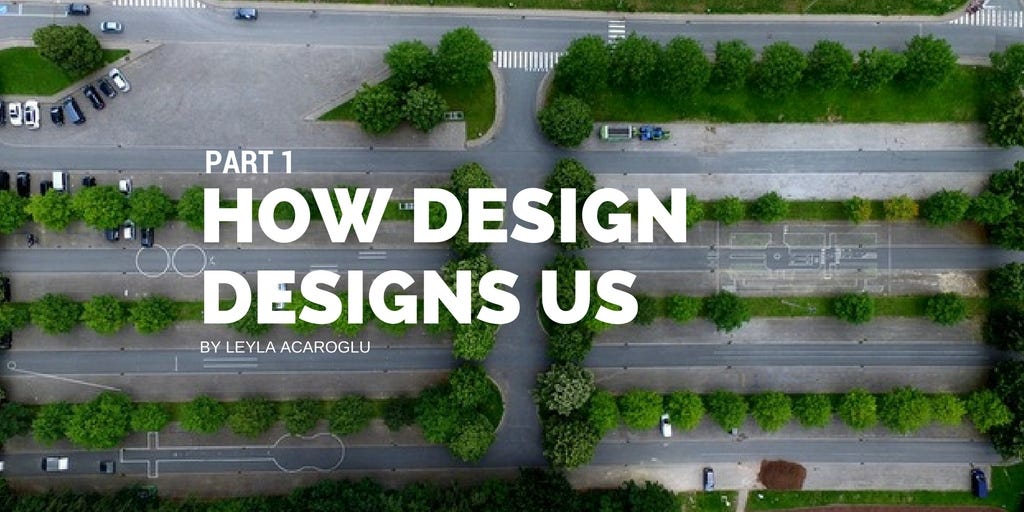
How Design Designs Us | Part 1: The Silent Social Scripter
In this three-part series, I’m exploring the ways in which design influences and affects our lives and how to unlock the emergent potential for design to create positive social change.
I believe design can be used as a catalyst for positive social change, but much design is done without the intent to create outcomes that do so. As a result, we end up living with things we don’t need, and solving problems that don’t exist, whilst ignoring the really critical ones. In order to first understand this and then inspire change in the design process, we need to understand how design, indeed, designs us.
Design is a phenomenal influencer; it is a silent social scripter that softly shifts and curates the values, options, cultures, and experiences of humans all over the world. I challenge you to find a moment in your life where you have not encountered a designed artifact, experience, or convention.
The products we create are actually the products of socially-constructed environments. We create the means, tools, languages, and schemas in which the designs exact, and they, in turn, design us.
Fast forward a couple hundred years of industrialization, and we are starting to feel the ramifications of these unintended design outcomes. One of the pioneers of this thinking around critiquing the role of design, Victor Papanek, first asserted this notion in the 1970s, in his book Design for the Real World: Human Ecology and Social Change: “Design, if it is to be ecologically responsible and socially responsive, must be revolutionary and radical.” The warning signs he and many other protagonists of his era, have been largely ignored, and now we are, in some cases, scrambling to figure out how to reform
From climate change to perpetually sore “tech necks,” everything in the material world leaves its mark on us as humans, on the species we share the planet with, and on the cognitive experiences that we collectively experience.
Ubiquitous everyday design subtly maneuvers and manipulates our experiences of the word, making us walk in particular directions and think in preformed ways, crafting our bodies through the physical realm, and reprogramming our minds through digital experiences. From products to services, to the systems around us, the material world embodies intent. Yet, we only seem to notice ‘bad’ or broken designs. Why is that?
The human brain loves efficiency. When things work for us, the brain responds with reward. Conversely, when things don’t work — when the brain encounters things that are frustrating or outside of its programmed set — it responds with stress. This knowledge has influenced countless products to be designed specifically to evoke strong emotional responses of love and desire, but conversely, many are designed to trigger stress and discomfort. The world is designed, and yet, the world designs us. We are trapped in a dynamic feedback loop between what we create as a species and the ways in which our created artifacts make us a species.

This idea is captured well in the concept of Ontological Design (Jason Silver has a great synopsis of the notion: watch here).
For example, think about the last time you moved to a new house. There would have been a period of time where you had to cognitively reprogram your brain to learn the new surroundings, as well as specifically how to get home. The well-worn neuropathways of the previous address have to be re-written with the new visual cues and way-finding processes that will lead you to your new front door. Similarly, a new job requires you to re-learn all the systems that will eventually allow for a form of automation or flow.
I am bit of a sustainability nut, so I only ever get second-hand phones. A couple of years ago, I was given an old iPhone and spent a few days adjusting to the user experience of the iPhone (Apple is known for making cerebrally positive UX). To exit a message, I pushed the top left hand arrow; to make a period in a message, I double clicked the space bar. All of these efficiency mechanisms quickly mapped to my brain and became intuitive behaviors. Last week that phone took its last breath of technological air, and another second-hand replacement came into my life, this time in the form of an Android. What do you think happened to my brain? (But first, if you are wondering what I did with the dead iPhone, I found an e-waste recycler!)
The back arrow on a message in an Android is at the bottom left, and the space bar does not create a period when double clicked. I struggled through a viscerally uncomfortable adjustment period of remapping brain processes; for a few days, all of my pre-worn intuitive actions had to be reprogrammed. The new user experience and I had to spend quality time getting in sync with each other. But I didn’t decide on any of these features. I am implicated in the decisions of the designer, and am therefore required to buy into the processes plus the user flow that was predetermined by someone else. Yes, many of these opposing decisions are intentional due to copy-write issues and competition between rival operating systems, but the fact is, I very quickly passed through the cognitively uncomfortable stages of remapping and was rapidly conditioned into an entirely new operating procedure. Does it make you pause, knowing that you (and your brain) are at the whim of whoever designed the products and experiences that you love and use, and even, at times, despise?

Design, whether you like it or not, is manipulating your brain and making you do things in particular ways. Of course, there is autonomy of choice and you can opt in or out of particular designed experiences, such as the hacks we make in our phones’ UX, or the ‘desire paths’ humans make when walking around pre-determined paths. (Have you ever cut through the grass instead of sticking to the paved walkway? You should listen to this great podcast on desire paths by 99% invisible.)
This all begs the question: if design is so powerful as a social and neurological influencer, how can we design well-crafted tools and experiences that affect and increase positive social outcomes? How can we use design as a catalyst for activating the cerebral elements that enable and empower people, rather than pacify and placate?
I have been considering actionable answers to this very question, especially since this is a central focus at the UnSchool. Check out part two next week of this three-part series to see what answers I discovered and what questions I am still exploring.